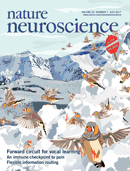 When a neuroscientist noticed there were problems with his January 2017 paper in Nature Neuroscience, he didn’t wait for the journal to take action — instead, he published his concerns about four figures on PubMed Commons. Months later, the journal has issued formal corrections to those figures — along with several more.
When a neuroscientist noticed there were problems with his January 2017 paper in Nature Neuroscience, he didn’t wait for the journal to take action — instead, he published his concerns about four figures on PubMed Commons. Months later, the journal has issued formal corrections to those figures — along with several more.
In February 2017, we praised Garret Stuber for alerting the scientific community to issues in his paper only 10 days after it first appeared online. On Twitter, he directed followers to the comment on PubMed Commons and asked them to retweet “for the sake of science integrity” — yet another example of how more researchers are taking matters into their own hands to alert readers to flaws in their papers. But according to the journal, the problems with the paper were more extensive than Stuber initially reported.
In February, Stuber wrote that he had become aware of duplication errors in three images and another problem with a fourth image. Stuber, who is based at the University of North Carolina at Chapel Hill, described how he planned to fix the issues and said he had already alerted the journal.
On June 30, Nature Neuroscience published two corrections to the paper, “Hormonal gain control of a medial preoptic area social reward circuit” — the lengthy corrigendum which details errors in dozens of images, and a brief notice describing an error introduced during the production process.
A spokesperson for Nature Neuroscience told us:
The corrigendum is published following an investigation of concerns raised regarding the figures in the paper. The figures and text have been corrected, and we have concluded that the corrected analysis and figures do not change the results or conclusions of the paper.
The second erratum explained that some images in the original paper were replaced because they were “pixelated as a result of the production processes used to create the online version.”
The errors appear to be much more extensive than Stuber first declared, and include problems with the data analysis, mistakes in the reported percentages, and number of neurons and mice, as well as duplications and missing data points.
The spokesperson explained:
In consultation with the journal, the authors carefully considered all the issues raised and carried out a thorough audit of the paper to generate a comprehensive correction statement. During the course of this full, careful reanalysis, they identified other figures that needed to be corrected, and detailed explanations of post hoc comparisons were added for the purposes of clarification.
According to the lengthy correction:
In the version of this article initially published, there were errors in data analysis and presentation. The corrected analysis and presentation do not change the results or interpretation of the data. Asterisk definitions have also been added for clarity as noted below. Changes with respect to the number of subjects reflect errors in reporting only and did not affect the data analysis.
The notice then goes on to identify and correct each error. For example:
Figure 5b originally contained duplicate example traces of calcium transients that were supposed to be taken from three individual neurons
And:
In Figure 8g, the vertical axis was truncated at 250, resulting in missing data points
Here’s the second correction:
In the version of this article initially published, images were pixelated as a result of the production processes used to create the online version. The images have been replaced in the HTML and PDF versions of the article.
The spokesperson also told us:
These corrections were each minor, in that the conclusions that can be drawn from the data did not change, but important for ensuring the accuracy and transparency of the data presentation. Once the full vetting of the paper had occurred, the editors consulted with referees and received feedback that the conclusions were not impacted by these changes.
Stuber said he didn’t have anything to add to the correction notice:
I agree with the statement that the journal provided.
Like Retraction Watch? Consider making a tax-deductible contribution to support our growth. You can also follow us on Twitter, like us on Facebook, add us to your RSS reader, sign up on our homepage for an email every time there’s a new post, or subscribe to our daily digest. Click here to review our Comments Policy. For a sneak peek at what we’re working on, click here.
It’s starting to look like someday we’ll all just be writing whatever it takes to get that turd published, then we’ll sort out the ‘truthiness’ part in post-pub corrections.